Vaccination Argument Analysis: Strengths, Weaknesses, and Rhetoric
VerifiedAdded on 2022/12/30
|12
|3806
|1
Report
AI Summary
This report provides a detailed analysis of an argument against vaccination, focusing on its logical structure, strengths, and weaknesses. The analysis begins with a standardization of the argument, identifying the main conclusion and supporting premises. The report then critically evaluates each premise, assessing the validity of the evidence presented and identifying any logical fallacies, such as appeal to authority, ad hominem, and mistaken correlation. The analysis extends to the rhetoric used in the argument, examining emotionally charged language, loaded words, and weaseling terms. The report also investigates the AVAG's (presumably a group) use of cited papers, assessing their relevance and impact. Finally, the report provides recommendations to strengthen the argument and improve the clarity and validity of the claims made. This analysis aims to provide a comprehensive understanding of the argument's persuasive techniques and logical flaws.

Paraphrase This Document
Need a fresh take? Get an instant paraphrase of this document with our AI Paraphraser
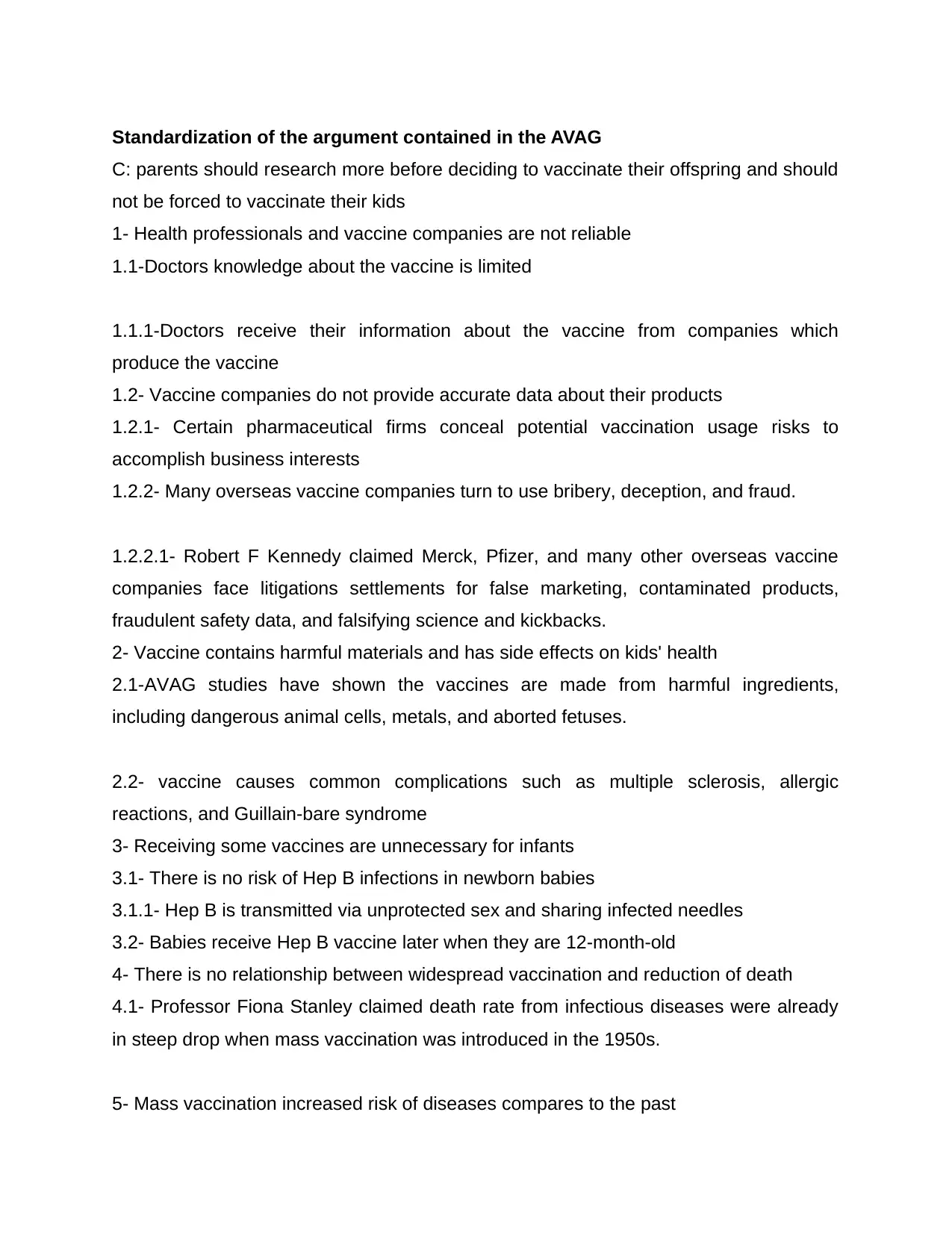
Standardization of the argument contained in the AVAG
C: parents should research more before deciding to vaccinate their offspring and should
not be forced to vaccinate their kids
1- Health professionals and vaccine companies are not reliable
1.1-Doctors knowledge about the vaccine is limited
1.1.1-Doctors receive their information about the vaccine from companies which
produce the vaccine
1.2- Vaccine companies do not provide accurate data about their products
1.2.1- Certain pharmaceutical firms conceal potential vaccination usage risks to
accomplish business interests
1.2.2- Many overseas vaccine companies turn to use bribery, deception, and fraud.
1.2.2.1- Robert F Kennedy claimed Merck, Pfizer, and many other overseas vaccine
companies face litigations settlements for false marketing, contaminated products,
fraudulent safety data, and falsifying science and kickbacks.
2- Vaccine contains harmful materials and has side effects on kids' health
2.1-AVAG studies have shown the vaccines are made from harmful ingredients,
including dangerous animal cells, metals, and aborted fetuses.
2.2- vaccine causes common complications such as multiple sclerosis, allergic
reactions, and Guillain-bare syndrome
3- Receiving some vaccines are unnecessary for infants
3.1- There is no risk of Hep B infections in newborn babies
3.1.1- Hep B is transmitted via unprotected sex and sharing infected needles
3.2- Babies receive Hep B vaccine later when they are 12-month-old
4- There is no relationship between widespread vaccination and reduction of death
4.1- Professor Fiona Stanley claimed death rate from infectious diseases were already
in steep drop when mass vaccination was introduced in the 1950s.
5- Mass vaccination increased risk of diseases compares to the past
C: parents should research more before deciding to vaccinate their offspring and should
not be forced to vaccinate their kids
1- Health professionals and vaccine companies are not reliable
1.1-Doctors knowledge about the vaccine is limited
1.1.1-Doctors receive their information about the vaccine from companies which
produce the vaccine
1.2- Vaccine companies do not provide accurate data about their products
1.2.1- Certain pharmaceutical firms conceal potential vaccination usage risks to
accomplish business interests
1.2.2- Many overseas vaccine companies turn to use bribery, deception, and fraud.
1.2.2.1- Robert F Kennedy claimed Merck, Pfizer, and many other overseas vaccine
companies face litigations settlements for false marketing, contaminated products,
fraudulent safety data, and falsifying science and kickbacks.
2- Vaccine contains harmful materials and has side effects on kids' health
2.1-AVAG studies have shown the vaccines are made from harmful ingredients,
including dangerous animal cells, metals, and aborted fetuses.
2.2- vaccine causes common complications such as multiple sclerosis, allergic
reactions, and Guillain-bare syndrome
3- Receiving some vaccines are unnecessary for infants
3.1- There is no risk of Hep B infections in newborn babies
3.1.1- Hep B is transmitted via unprotected sex and sharing infected needles
3.2- Babies receive Hep B vaccine later when they are 12-month-old
4- There is no relationship between widespread vaccination and reduction of death
4.1- Professor Fiona Stanley claimed death rate from infectious diseases were already
in steep drop when mass vaccination was introduced in the 1950s.
5- Mass vaccination increased risk of diseases compares to the past
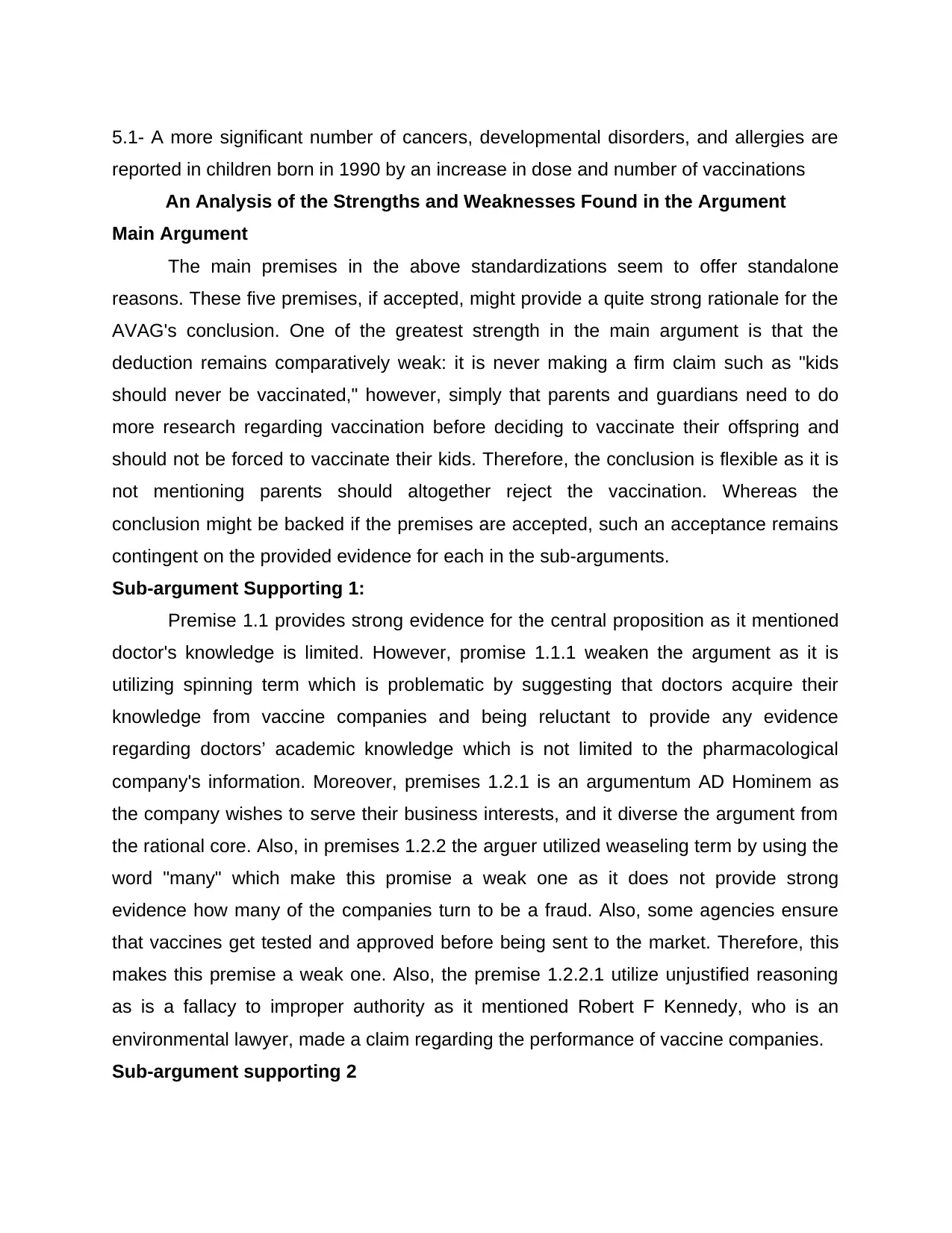
5.1- A more significant number of cancers, developmental disorders, and allergies are
reported in children born in 1990 by an increase in dose and number of vaccinations
An Analysis of the Strengths and Weaknesses Found in the Argument
Main Argument
The main premises in the above standardizations seem to offer standalone
reasons. These five premises, if accepted, might provide a quite strong rationale for the
AVAG's conclusion. One of the greatest strength in the main argument is that the
deduction remains comparatively weak: it is never making a firm claim such as "kids
should never be vaccinated," however, simply that parents and guardians need to do
more research regarding vaccination before deciding to vaccinate their offspring and
should not be forced to vaccinate their kids. Therefore, the conclusion is flexible as it is
not mentioning parents should altogether reject the vaccination. Whereas the
conclusion might be backed if the premises are accepted, such an acceptance remains
contingent on the provided evidence for each in the sub-arguments.
Sub-argument Supporting 1:
Premise 1.1 provides strong evidence for the central proposition as it mentioned
doctor's knowledge is limited. However, promise 1.1.1 weaken the argument as it is
utilizing spinning term which is problematic by suggesting that doctors acquire their
knowledge from vaccine companies and being reluctant to provide any evidence
regarding doctors’ academic knowledge which is not limited to the pharmacological
company's information. Moreover, premises 1.2.1 is an argumentum AD Hominem as
the company wishes to serve their business interests, and it diverse the argument from
the rational core. Also, in premises 1.2.2 the arguer utilized weaseling term by using the
word "many" which make this promise a weak one as it does not provide strong
evidence how many of the companies turn to be a fraud. Also, some agencies ensure
that vaccines get tested and approved before being sent to the market. Therefore, this
makes this premise a weak one. Also, the premise 1.2.2.1 utilize unjustified reasoning
as is a fallacy to improper authority as it mentioned Robert F Kennedy, who is an
environmental lawyer, made a claim regarding the performance of vaccine companies.
Sub-argument supporting 2
reported in children born in 1990 by an increase in dose and number of vaccinations
An Analysis of the Strengths and Weaknesses Found in the Argument
Main Argument
The main premises in the above standardizations seem to offer standalone
reasons. These five premises, if accepted, might provide a quite strong rationale for the
AVAG's conclusion. One of the greatest strength in the main argument is that the
deduction remains comparatively weak: it is never making a firm claim such as "kids
should never be vaccinated," however, simply that parents and guardians need to do
more research regarding vaccination before deciding to vaccinate their offspring and
should not be forced to vaccinate their kids. Therefore, the conclusion is flexible as it is
not mentioning parents should altogether reject the vaccination. Whereas the
conclusion might be backed if the premises are accepted, such an acceptance remains
contingent on the provided evidence for each in the sub-arguments.
Sub-argument Supporting 1:
Premise 1.1 provides strong evidence for the central proposition as it mentioned
doctor's knowledge is limited. However, promise 1.1.1 weaken the argument as it is
utilizing spinning term which is problematic by suggesting that doctors acquire their
knowledge from vaccine companies and being reluctant to provide any evidence
regarding doctors’ academic knowledge which is not limited to the pharmacological
company's information. Moreover, premises 1.2.1 is an argumentum AD Hominem as
the company wishes to serve their business interests, and it diverse the argument from
the rational core. Also, in premises 1.2.2 the arguer utilized weaseling term by using the
word "many" which make this promise a weak one as it does not provide strong
evidence how many of the companies turn to be a fraud. Also, some agencies ensure
that vaccines get tested and approved before being sent to the market. Therefore, this
makes this premise a weak one. Also, the premise 1.2.2.1 utilize unjustified reasoning
as is a fallacy to improper authority as it mentioned Robert F Kennedy, who is an
environmental lawyer, made a claim regarding the performance of vaccine companies.
Sub-argument supporting 2
⊘ This is a preview!⊘
Do you want full access?
Subscribe today to unlock all pages.

Trusted by 1+ million students worldwide
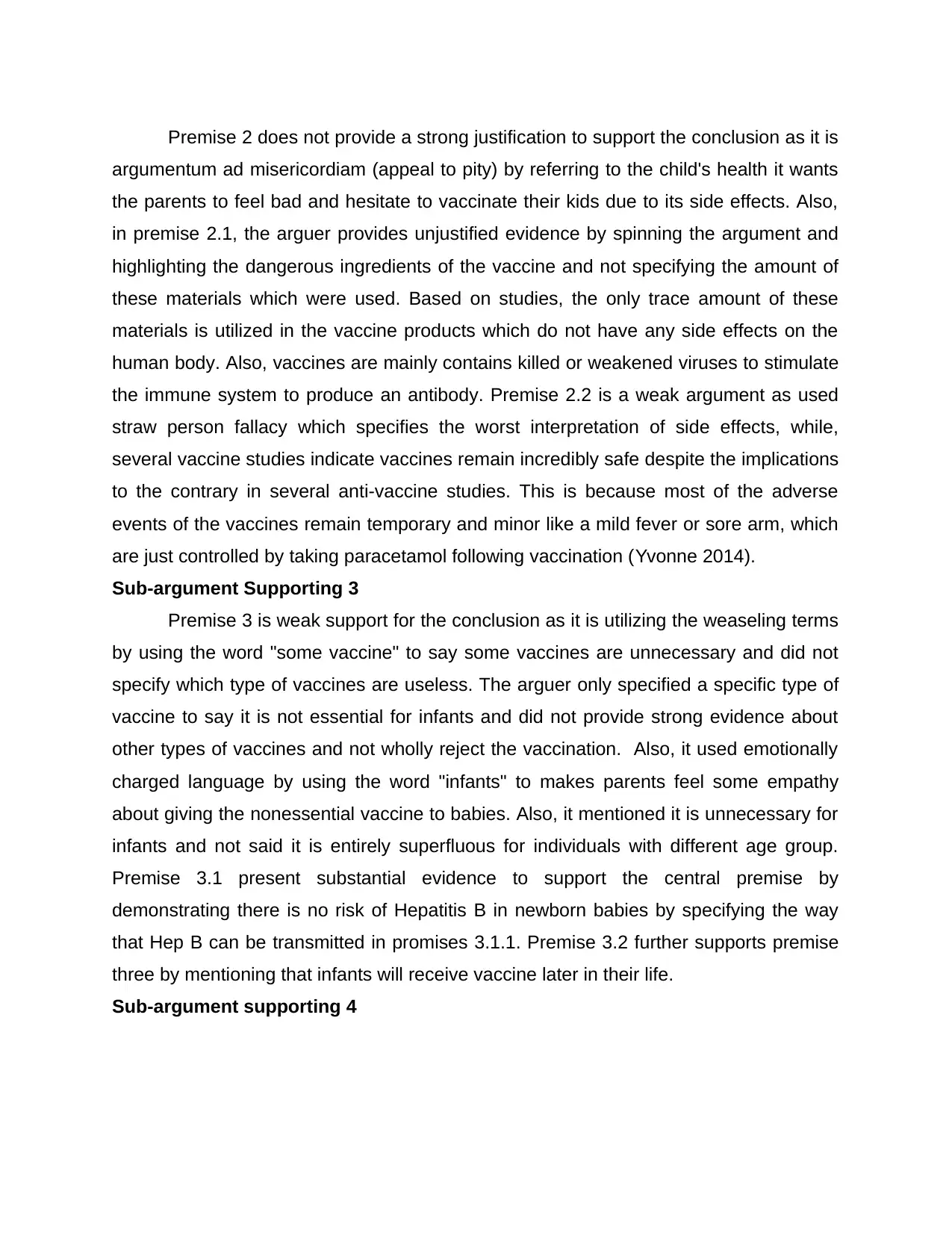
Premise 2 does not provide a strong justification to support the conclusion as it is
argumentum ad misericordiam (appeal to pity) by referring to the child's health it wants
the parents to feel bad and hesitate to vaccinate their kids due to its side effects. Also,
in premise 2.1, the arguer provides unjustified evidence by spinning the argument and
highlighting the dangerous ingredients of the vaccine and not specifying the amount of
these materials which were used. Based on studies, the only trace amount of these
materials is utilized in the vaccine products which do not have any side effects on the
human body. Also, vaccines are mainly contains killed or weakened viruses to stimulate
the immune system to produce an antibody. Premise 2.2 is a weak argument as used
straw person fallacy which specifies the worst interpretation of side effects, while,
several vaccine studies indicate vaccines remain incredibly safe despite the implications
to the contrary in several anti-vaccine studies. This is because most of the adverse
events of the vaccines remain temporary and minor like a mild fever or sore arm, which
are just controlled by taking paracetamol following vaccination (Yvonne 2014).
Sub-argument Supporting 3
Premise 3 is weak support for the conclusion as it is utilizing the weaseling terms
by using the word "some vaccine" to say some vaccines are unnecessary and did not
specify which type of vaccines are useless. The arguer only specified a specific type of
vaccine to say it is not essential for infants and did not provide strong evidence about
other types of vaccines and not wholly reject the vaccination. Also, it used emotionally
charged language by using the word "infants" to makes parents feel some empathy
about giving the nonessential vaccine to babies. Also, it mentioned it is unnecessary for
infants and not said it is entirely superfluous for individuals with different age group.
Premise 3.1 present substantial evidence to support the central premise by
demonstrating there is no risk of Hepatitis B in newborn babies by specifying the way
that Hep B can be transmitted in promises 3.1.1. Premise 3.2 further supports premise
three by mentioning that infants will receive vaccine later in their life.
Sub-argument supporting 4
argumentum ad misericordiam (appeal to pity) by referring to the child's health it wants
the parents to feel bad and hesitate to vaccinate their kids due to its side effects. Also,
in premise 2.1, the arguer provides unjustified evidence by spinning the argument and
highlighting the dangerous ingredients of the vaccine and not specifying the amount of
these materials which were used. Based on studies, the only trace amount of these
materials is utilized in the vaccine products which do not have any side effects on the
human body. Also, vaccines are mainly contains killed or weakened viruses to stimulate
the immune system to produce an antibody. Premise 2.2 is a weak argument as used
straw person fallacy which specifies the worst interpretation of side effects, while,
several vaccine studies indicate vaccines remain incredibly safe despite the implications
to the contrary in several anti-vaccine studies. This is because most of the adverse
events of the vaccines remain temporary and minor like a mild fever or sore arm, which
are just controlled by taking paracetamol following vaccination (Yvonne 2014).
Sub-argument Supporting 3
Premise 3 is weak support for the conclusion as it is utilizing the weaseling terms
by using the word "some vaccine" to say some vaccines are unnecessary and did not
specify which type of vaccines are useless. The arguer only specified a specific type of
vaccine to say it is not essential for infants and did not provide strong evidence about
other types of vaccines and not wholly reject the vaccination. Also, it used emotionally
charged language by using the word "infants" to makes parents feel some empathy
about giving the nonessential vaccine to babies. Also, it mentioned it is unnecessary for
infants and not said it is entirely superfluous for individuals with different age group.
Premise 3.1 present substantial evidence to support the central premise by
demonstrating there is no risk of Hepatitis B in newborn babies by specifying the way
that Hep B can be transmitted in promises 3.1.1. Premise 3.2 further supports premise
three by mentioning that infants will receive vaccine later in their life.
Sub-argument supporting 4
Paraphrase This Document
Need a fresh take? Get an instant paraphrase of this document with our AI Paraphraser
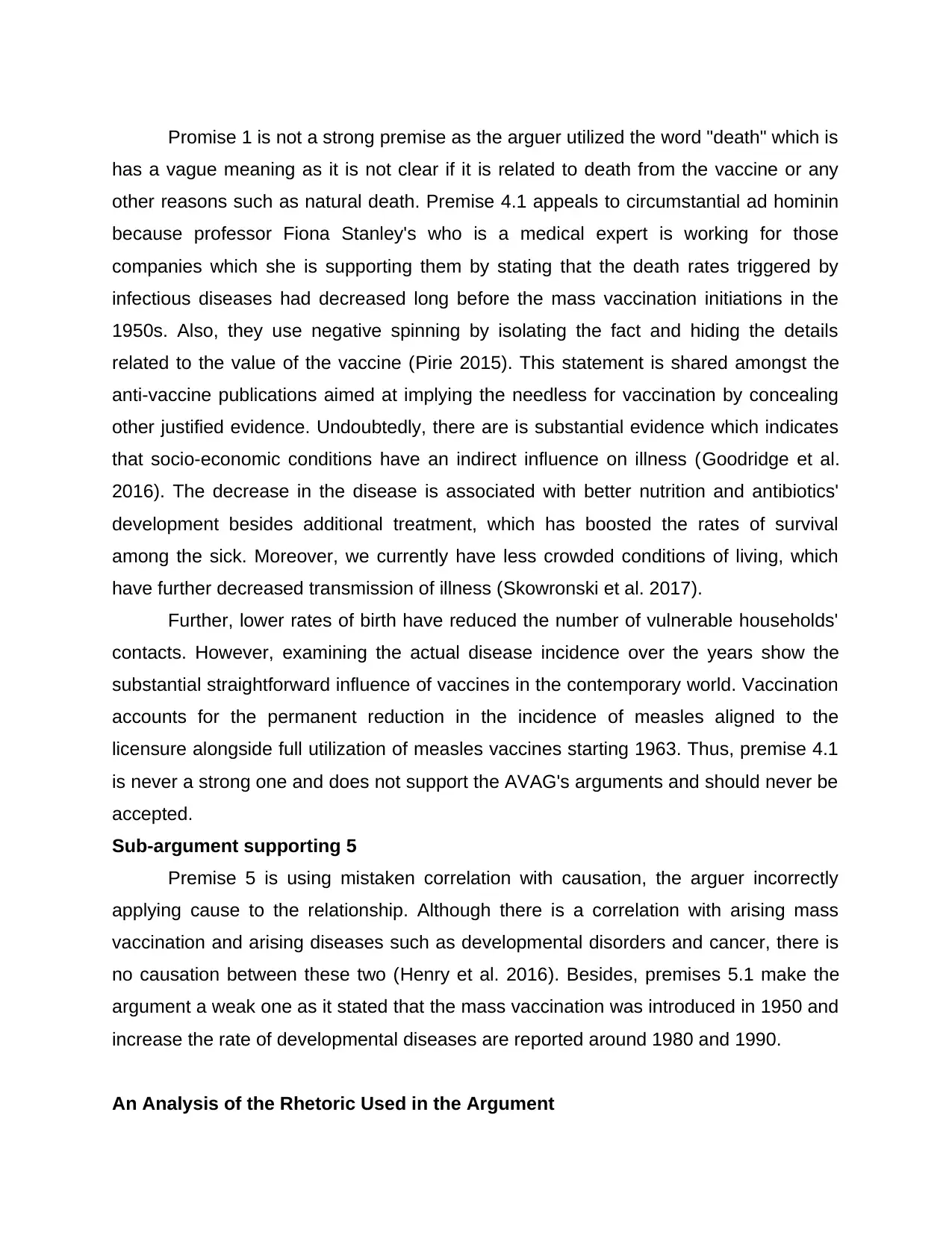
Promise 1 is not a strong premise as the arguer utilized the word "death" which is
has a vague meaning as it is not clear if it is related to death from the vaccine or any
other reasons such as natural death. Premise 4.1 appeals to circumstantial ad hominin
because professor Fiona Stanley's who is a medical expert is working for those
companies which she is supporting them by stating that the death rates triggered by
infectious diseases had decreased long before the mass vaccination initiations in the
1950s. Also, they use negative spinning by isolating the fact and hiding the details
related to the value of the vaccine (Pirie 2015). This statement is shared amongst the
anti-vaccine publications aimed at implying the needless for vaccination by concealing
other justified evidence. Undoubtedly, there are is substantial evidence which indicates
that socio-economic conditions have an indirect influence on illness (Goodridge et al.
2016). The decrease in the disease is associated with better nutrition and antibiotics'
development besides additional treatment, which has boosted the rates of survival
among the sick. Moreover, we currently have less crowded conditions of living, which
have further decreased transmission of illness (Skowronski et al. 2017).
Further, lower rates of birth have reduced the number of vulnerable households'
contacts. However, examining the actual disease incidence over the years show the
substantial straightforward influence of vaccines in the contemporary world. Vaccination
accounts for the permanent reduction in the incidence of measles aligned to the
licensure alongside full utilization of measles vaccines starting 1963. Thus, premise 4.1
is never a strong one and does not support the AVAG's arguments and should never be
accepted.
Sub-argument supporting 5
Premise 5 is using mistaken correlation with causation, the arguer incorrectly
applying cause to the relationship. Although there is a correlation with arising mass
vaccination and arising diseases such as developmental disorders and cancer, there is
no causation between these two (Henry et al. 2016). Besides, premises 5.1 make the
argument a weak one as it stated that the mass vaccination was introduced in 1950 and
increase the rate of developmental diseases are reported around 1980 and 1990.
An Analysis of the Rhetoric Used in the Argument
has a vague meaning as it is not clear if it is related to death from the vaccine or any
other reasons such as natural death. Premise 4.1 appeals to circumstantial ad hominin
because professor Fiona Stanley's who is a medical expert is working for those
companies which she is supporting them by stating that the death rates triggered by
infectious diseases had decreased long before the mass vaccination initiations in the
1950s. Also, they use negative spinning by isolating the fact and hiding the details
related to the value of the vaccine (Pirie 2015). This statement is shared amongst the
anti-vaccine publications aimed at implying the needless for vaccination by concealing
other justified evidence. Undoubtedly, there are is substantial evidence which indicates
that socio-economic conditions have an indirect influence on illness (Goodridge et al.
2016). The decrease in the disease is associated with better nutrition and antibiotics'
development besides additional treatment, which has boosted the rates of survival
among the sick. Moreover, we currently have less crowded conditions of living, which
have further decreased transmission of illness (Skowronski et al. 2017).
Further, lower rates of birth have reduced the number of vulnerable households'
contacts. However, examining the actual disease incidence over the years show the
substantial straightforward influence of vaccines in the contemporary world. Vaccination
accounts for the permanent reduction in the incidence of measles aligned to the
licensure alongside full utilization of measles vaccines starting 1963. Thus, premise 4.1
is never a strong one and does not support the AVAG's arguments and should never be
accepted.
Sub-argument supporting 5
Premise 5 is using mistaken correlation with causation, the arguer incorrectly
applying cause to the relationship. Although there is a correlation with arising mass
vaccination and arising diseases such as developmental disorders and cancer, there is
no causation between these two (Henry et al. 2016). Besides, premises 5.1 make the
argument a weak one as it stated that the mass vaccination was introduced in 1950 and
increase the rate of developmental diseases are reported around 1980 and 1990.
An Analysis of the Rhetoric Used in the Argument
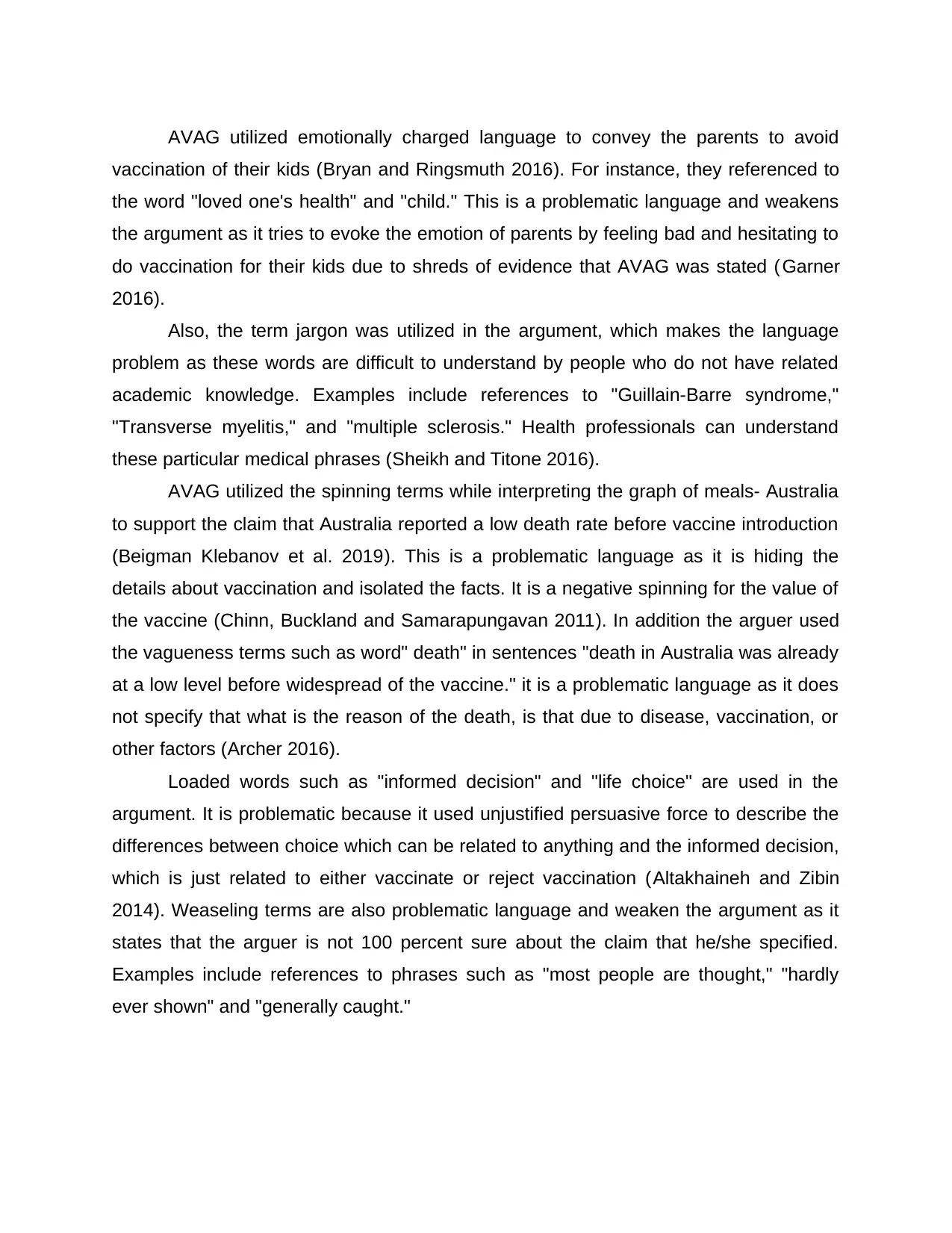
AVAG utilized emotionally charged language to convey the parents to avoid
vaccination of their kids (Bryan and Ringsmuth 2016). For instance, they referenced to
the word "loved one's health" and "child." This is a problematic language and weakens
the argument as it tries to evoke the emotion of parents by feeling bad and hesitating to
do vaccination for their kids due to shreds of evidence that AVAG was stated (Garner
2016).
Also, the term jargon was utilized in the argument, which makes the language
problem as these words are difficult to understand by people who do not have related
academic knowledge. Examples include references to "Guillain-Barre syndrome,"
"Transverse myelitis," and "multiple sclerosis." Health professionals can understand
these particular medical phrases (Sheikh and Titone 2016).
AVAG utilized the spinning terms while interpreting the graph of meals- Australia
to support the claim that Australia reported a low death rate before vaccine introduction
(Beigman Klebanov et al. 2019). This is a problematic language as it is hiding the
details about vaccination and isolated the facts. It is a negative spinning for the value of
the vaccine (Chinn, Buckland and Samarapungavan 2011). In addition the arguer used
the vagueness terms such as word" death" in sentences "death in Australia was already
at a low level before widespread of the vaccine." it is a problematic language as it does
not specify that what is the reason of the death, is that due to disease, vaccination, or
other factors (Archer 2016).
Loaded words such as "informed decision" and "life choice" are used in the
argument. It is problematic because it used unjustified persuasive force to describe the
differences between choice which can be related to anything and the informed decision,
which is just related to either vaccinate or reject vaccination (Altakhaineh and Zibin
2014). Weaseling terms are also problematic language and weaken the argument as it
states that the arguer is not 100 percent sure about the claim that he/she specified.
Examples include references to phrases such as "most people are thought," "hardly
ever shown" and "generally caught."
vaccination of their kids (Bryan and Ringsmuth 2016). For instance, they referenced to
the word "loved one's health" and "child." This is a problematic language and weakens
the argument as it tries to evoke the emotion of parents by feeling bad and hesitating to
do vaccination for their kids due to shreds of evidence that AVAG was stated (Garner
2016).
Also, the term jargon was utilized in the argument, which makes the language
problem as these words are difficult to understand by people who do not have related
academic knowledge. Examples include references to "Guillain-Barre syndrome,"
"Transverse myelitis," and "multiple sclerosis." Health professionals can understand
these particular medical phrases (Sheikh and Titone 2016).
AVAG utilized the spinning terms while interpreting the graph of meals- Australia
to support the claim that Australia reported a low death rate before vaccine introduction
(Beigman Klebanov et al. 2019). This is a problematic language as it is hiding the
details about vaccination and isolated the facts. It is a negative spinning for the value of
the vaccine (Chinn, Buckland and Samarapungavan 2011). In addition the arguer used
the vagueness terms such as word" death" in sentences "death in Australia was already
at a low level before widespread of the vaccine." it is a problematic language as it does
not specify that what is the reason of the death, is that due to disease, vaccination, or
other factors (Archer 2016).
Loaded words such as "informed decision" and "life choice" are used in the
argument. It is problematic because it used unjustified persuasive force to describe the
differences between choice which can be related to anything and the informed decision,
which is just related to either vaccinate or reject vaccination (Altakhaineh and Zibin
2014). Weaseling terms are also problematic language and weaken the argument as it
states that the arguer is not 100 percent sure about the claim that he/she specified.
Examples include references to phrases such as "most people are thought," "hardly
ever shown" and "generally caught."
⊘ This is a preview!⊘
Do you want full access?
Subscribe today to unlock all pages.

Trusted by 1+ million students worldwide
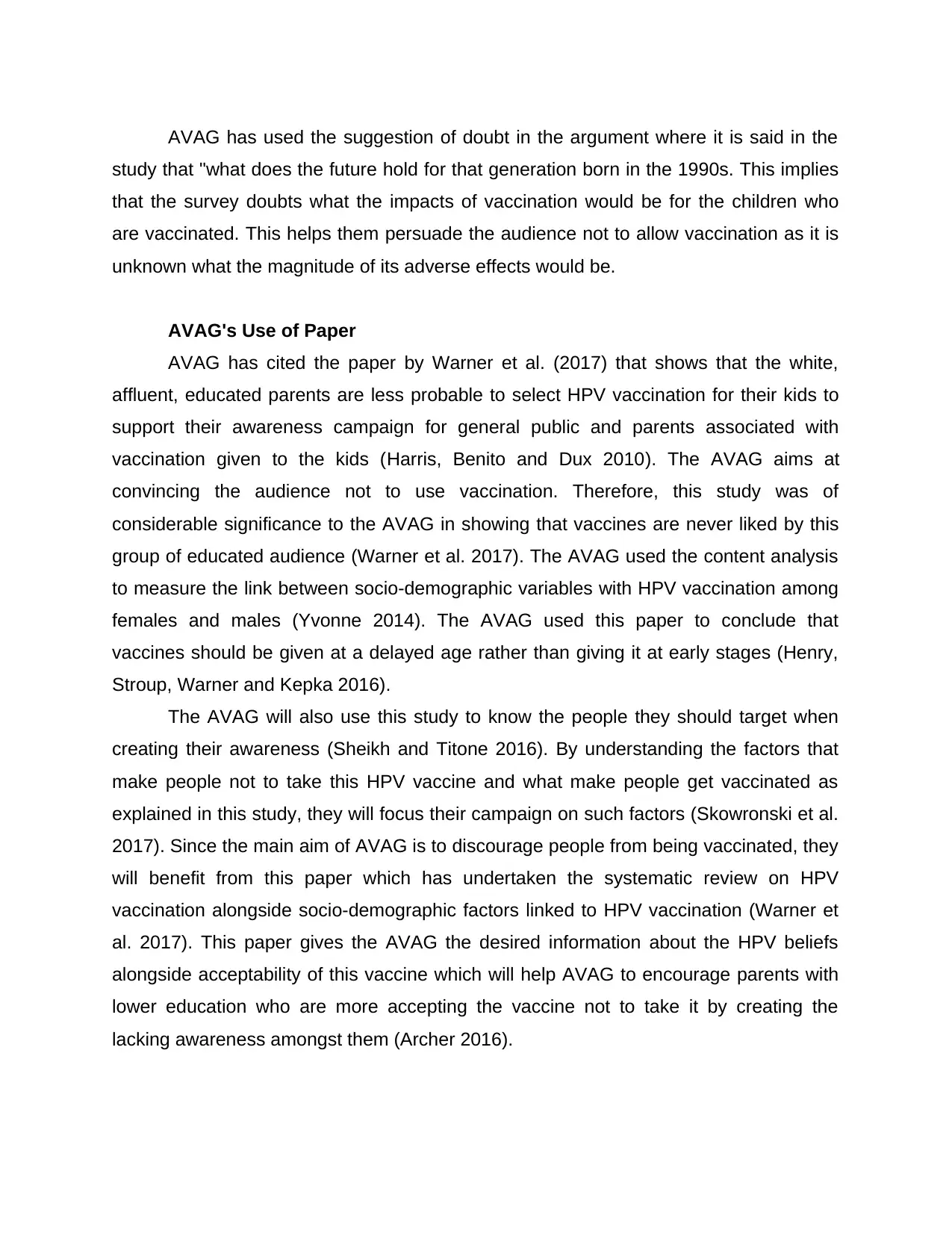
AVAG has used the suggestion of doubt in the argument where it is said in the
study that "what does the future hold for that generation born in the 1990s. This implies
that the survey doubts what the impacts of vaccination would be for the children who
are vaccinated. This helps them persuade the audience not to allow vaccination as it is
unknown what the magnitude of its adverse effects would be.
AVAG's Use of Paper
AVAG has cited the paper by Warner et al. (2017) that shows that the white,
affluent, educated parents are less probable to select HPV vaccination for their kids to
support their awareness campaign for general public and parents associated with
vaccination given to the kids (Harris, Benito and Dux 2010). The AVAG aims at
convincing the audience not to use vaccination. Therefore, this study was of
considerable significance to the AVAG in showing that vaccines are never liked by this
group of educated audience (Warner et al. 2017). The AVAG used the content analysis
to measure the link between socio-demographic variables with HPV vaccination among
females and males (Yvonne 2014). The AVAG used this paper to conclude that
vaccines should be given at a delayed age rather than giving it at early stages (Henry,
Stroup, Warner and Kepka 2016).
The AVAG will also use this study to know the people they should target when
creating their awareness (Sheikh and Titone 2016). By understanding the factors that
make people not to take this HPV vaccine and what make people get vaccinated as
explained in this study, they will focus their campaign on such factors (Skowronski et al.
2017). Since the main aim of AVAG is to discourage people from being vaccinated, they
will benefit from this paper which has undertaken the systematic review on HPV
vaccination alongside socio-demographic factors linked to HPV vaccination (Warner et
al. 2017). This paper gives the AVAG the desired information about the HPV beliefs
alongside acceptability of this vaccine which will help AVAG to encourage parents with
lower education who are more accepting the vaccine not to take it by creating the
lacking awareness amongst them (Archer 2016).
study that "what does the future hold for that generation born in the 1990s. This implies
that the survey doubts what the impacts of vaccination would be for the children who
are vaccinated. This helps them persuade the audience not to allow vaccination as it is
unknown what the magnitude of its adverse effects would be.
AVAG's Use of Paper
AVAG has cited the paper by Warner et al. (2017) that shows that the white,
affluent, educated parents are less probable to select HPV vaccination for their kids to
support their awareness campaign for general public and parents associated with
vaccination given to the kids (Harris, Benito and Dux 2010). The AVAG aims at
convincing the audience not to use vaccination. Therefore, this study was of
considerable significance to the AVAG in showing that vaccines are never liked by this
group of educated audience (Warner et al. 2017). The AVAG used the content analysis
to measure the link between socio-demographic variables with HPV vaccination among
females and males (Yvonne 2014). The AVAG used this paper to conclude that
vaccines should be given at a delayed age rather than giving it at early stages (Henry,
Stroup, Warner and Kepka 2016).
The AVAG will also use this study to know the people they should target when
creating their awareness (Sheikh and Titone 2016). By understanding the factors that
make people not to take this HPV vaccine and what make people get vaccinated as
explained in this study, they will focus their campaign on such factors (Skowronski et al.
2017). Since the main aim of AVAG is to discourage people from being vaccinated, they
will benefit from this paper which has undertaken the systematic review on HPV
vaccination alongside socio-demographic factors linked to HPV vaccination (Warner et
al. 2017). This paper gives the AVAG the desired information about the HPV beliefs
alongside acceptability of this vaccine which will help AVAG to encourage parents with
lower education who are more accepting the vaccine not to take it by creating the
lacking awareness amongst them (Archer 2016).
Paraphrase This Document
Need a fresh take? Get an instant paraphrase of this document with our AI Paraphraser
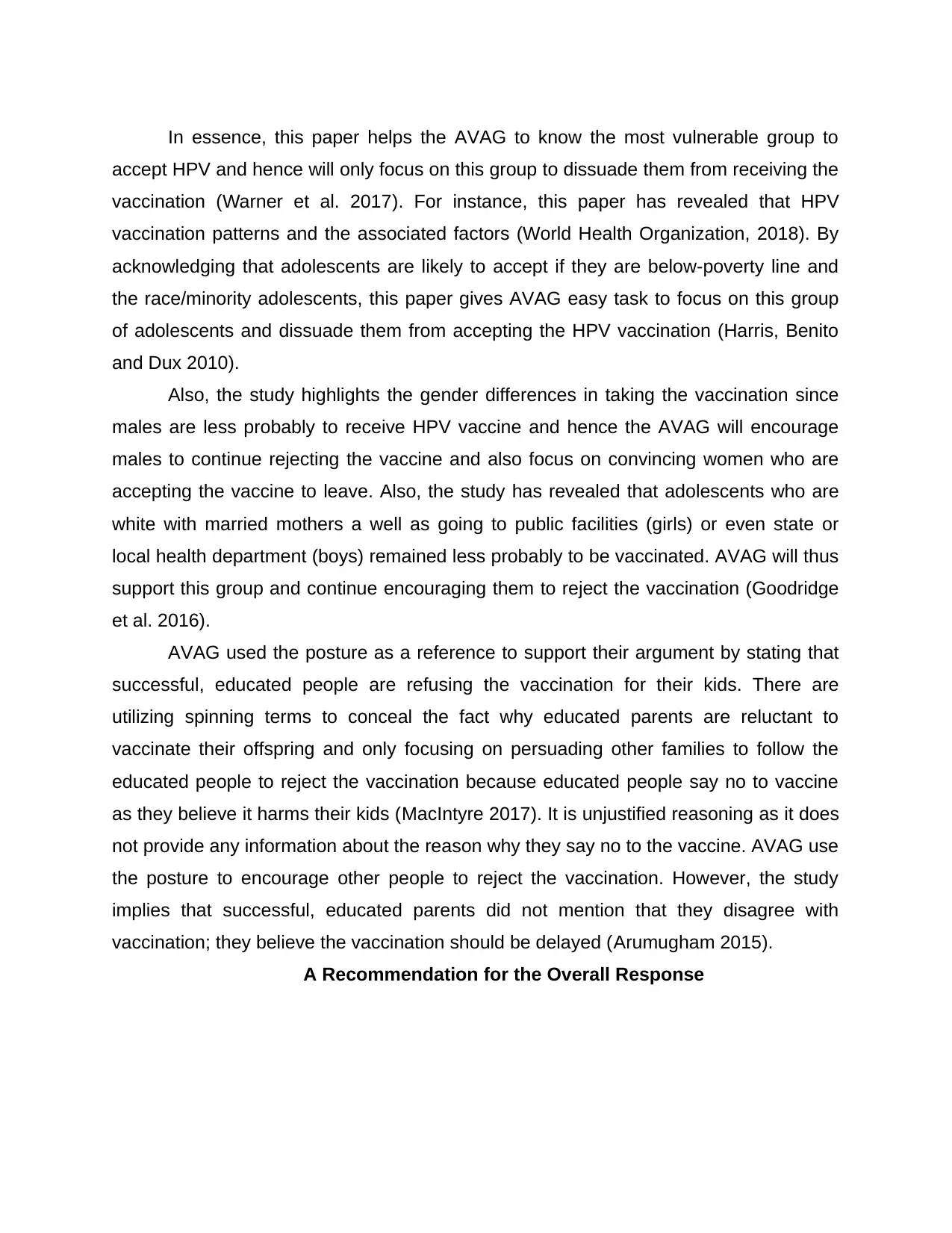
In essence, this paper helps the AVAG to know the most vulnerable group to
accept HPV and hence will only focus on this group to dissuade them from receiving the
vaccination (Warner et al. 2017). For instance, this paper has revealed that HPV
vaccination patterns and the associated factors (World Health Organization, 2018). By
acknowledging that adolescents are likely to accept if they are below-poverty line and
the race/minority adolescents, this paper gives AVAG easy task to focus on this group
of adolescents and dissuade them from accepting the HPV vaccination (Harris, Benito
and Dux 2010).
Also, the study highlights the gender differences in taking the vaccination since
males are less probably to receive HPV vaccine and hence the AVAG will encourage
males to continue rejecting the vaccine and also focus on convincing women who are
accepting the vaccine to leave. Also, the study has revealed that adolescents who are
white with married mothers a well as going to public facilities (girls) or even state or
local health department (boys) remained less probably to be vaccinated. AVAG will thus
support this group and continue encouraging them to reject the vaccination (Goodridge
et al. 2016).
AVAG used the posture as a reference to support their argument by stating that
successful, educated people are refusing the vaccination for their kids. There are
utilizing spinning terms to conceal the fact why educated parents are reluctant to
vaccinate their offspring and only focusing on persuading other families to follow the
educated people to reject the vaccination because educated people say no to vaccine
as they believe it harms their kids (MacIntyre 2017). It is unjustified reasoning as it does
not provide any information about the reason why they say no to the vaccine. AVAG use
the posture to encourage other people to reject the vaccination. However, the study
implies that successful, educated parents did not mention that they disagree with
vaccination; they believe the vaccination should be delayed (Arumugham 2015).
A Recommendation for the Overall Response
accept HPV and hence will only focus on this group to dissuade them from receiving the
vaccination (Warner et al. 2017). For instance, this paper has revealed that HPV
vaccination patterns and the associated factors (World Health Organization, 2018). By
acknowledging that adolescents are likely to accept if they are below-poverty line and
the race/minority adolescents, this paper gives AVAG easy task to focus on this group
of adolescents and dissuade them from accepting the HPV vaccination (Harris, Benito
and Dux 2010).
Also, the study highlights the gender differences in taking the vaccination since
males are less probably to receive HPV vaccine and hence the AVAG will encourage
males to continue rejecting the vaccine and also focus on convincing women who are
accepting the vaccine to leave. Also, the study has revealed that adolescents who are
white with married mothers a well as going to public facilities (girls) or even state or
local health department (boys) remained less probably to be vaccinated. AVAG will thus
support this group and continue encouraging them to reject the vaccination (Goodridge
et al. 2016).
AVAG used the posture as a reference to support their argument by stating that
successful, educated people are refusing the vaccination for their kids. There are
utilizing spinning terms to conceal the fact why educated parents are reluctant to
vaccinate their offspring and only focusing on persuading other families to follow the
educated people to reject the vaccination because educated people say no to vaccine
as they believe it harms their kids (MacIntyre 2017). It is unjustified reasoning as it does
not provide any information about the reason why they say no to the vaccine. AVAG use
the posture to encourage other people to reject the vaccination. However, the study
implies that successful, educated parents did not mention that they disagree with
vaccination; they believe the vaccination should be delayed (Arumugham 2015).
A Recommendation for the Overall Response
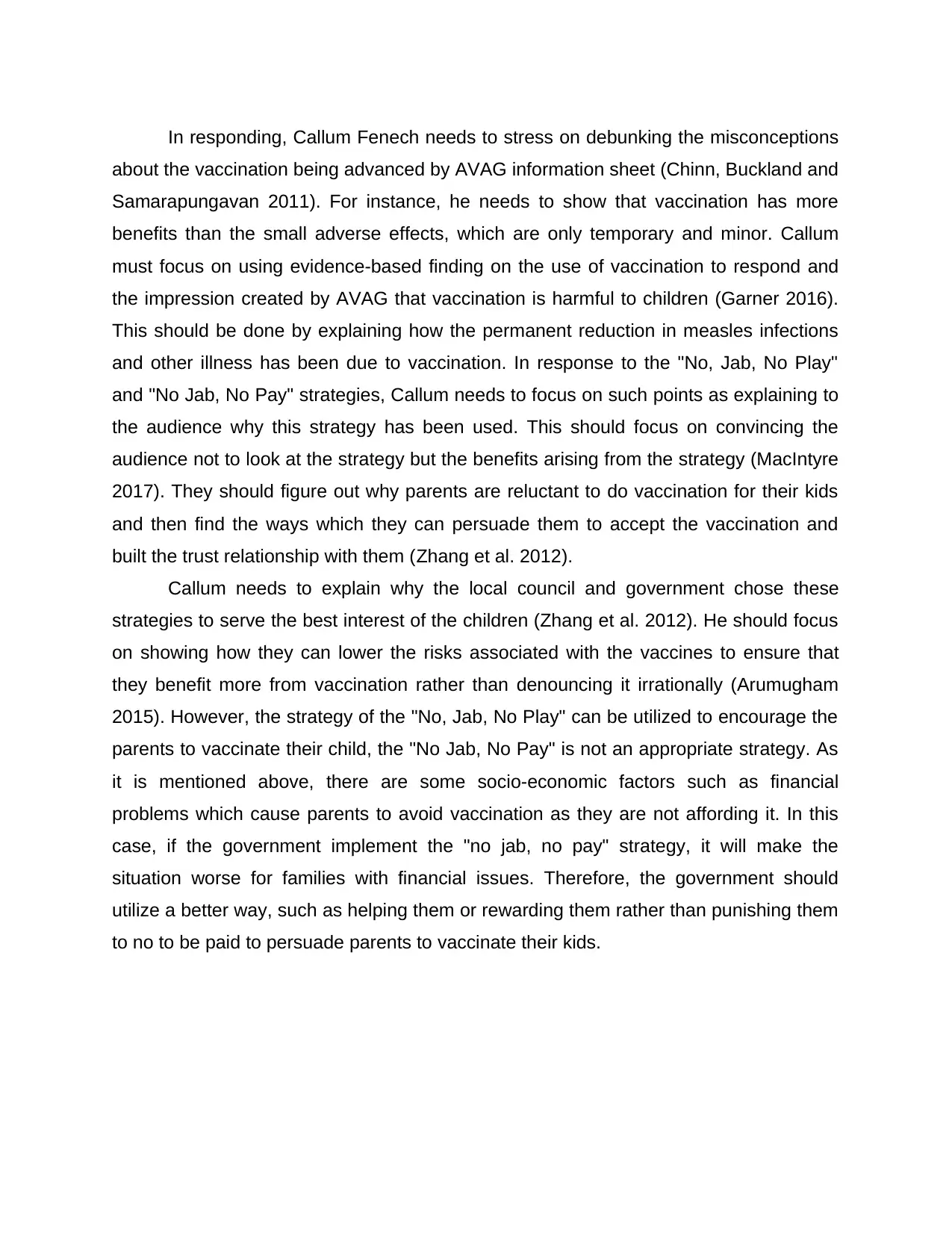
In responding, Callum Fenech needs to stress on debunking the misconceptions
about the vaccination being advanced by AVAG information sheet (Chinn, Buckland and
Samarapungavan 2011). For instance, he needs to show that vaccination has more
benefits than the small adverse effects, which are only temporary and minor. Callum
must focus on using evidence-based finding on the use of vaccination to respond and
the impression created by AVAG that vaccination is harmful to children (Garner 2016).
This should be done by explaining how the permanent reduction in measles infections
and other illness has been due to vaccination. In response to the "No, Jab, No Play"
and "No Jab, No Pay" strategies, Callum needs to focus on such points as explaining to
the audience why this strategy has been used. This should focus on convincing the
audience not to look at the strategy but the benefits arising from the strategy (MacIntyre
2017). They should figure out why parents are reluctant to do vaccination for their kids
and then find the ways which they can persuade them to accept the vaccination and
built the trust relationship with them (Zhang et al. 2012).
Callum needs to explain why the local council and government chose these
strategies to serve the best interest of the children (Zhang et al. 2012). He should focus
on showing how they can lower the risks associated with the vaccines to ensure that
they benefit more from vaccination rather than denouncing it irrationally (Arumugham
2015). However, the strategy of the "No, Jab, No Play" can be utilized to encourage the
parents to vaccinate their child, the "No Jab, No Pay" is not an appropriate strategy. As
it is mentioned above, there are some socio-economic factors such as financial
problems which cause parents to avoid vaccination as they are not affording it. In this
case, if the government implement the "no jab, no pay" strategy, it will make the
situation worse for families with financial issues. Therefore, the government should
utilize a better way, such as helping them or rewarding them rather than punishing them
to no to be paid to persuade parents to vaccinate their kids.
about the vaccination being advanced by AVAG information sheet (Chinn, Buckland and
Samarapungavan 2011). For instance, he needs to show that vaccination has more
benefits than the small adverse effects, which are only temporary and minor. Callum
must focus on using evidence-based finding on the use of vaccination to respond and
the impression created by AVAG that vaccination is harmful to children (Garner 2016).
This should be done by explaining how the permanent reduction in measles infections
and other illness has been due to vaccination. In response to the "No, Jab, No Play"
and "No Jab, No Pay" strategies, Callum needs to focus on such points as explaining to
the audience why this strategy has been used. This should focus on convincing the
audience not to look at the strategy but the benefits arising from the strategy (MacIntyre
2017). They should figure out why parents are reluctant to do vaccination for their kids
and then find the ways which they can persuade them to accept the vaccination and
built the trust relationship with them (Zhang et al. 2012).
Callum needs to explain why the local council and government chose these
strategies to serve the best interest of the children (Zhang et al. 2012). He should focus
on showing how they can lower the risks associated with the vaccines to ensure that
they benefit more from vaccination rather than denouncing it irrationally (Arumugham
2015). However, the strategy of the "No, Jab, No Play" can be utilized to encourage the
parents to vaccinate their child, the "No Jab, No Pay" is not an appropriate strategy. As
it is mentioned above, there are some socio-economic factors such as financial
problems which cause parents to avoid vaccination as they are not affording it. In this
case, if the government implement the "no jab, no pay" strategy, it will make the
situation worse for families with financial issues. Therefore, the government should
utilize a better way, such as helping them or rewarding them rather than punishing them
to no to be paid to persuade parents to vaccinate their kids.
⊘ This is a preview!⊘
Do you want full access?
Subscribe today to unlock all pages.

Trusted by 1+ million students worldwide
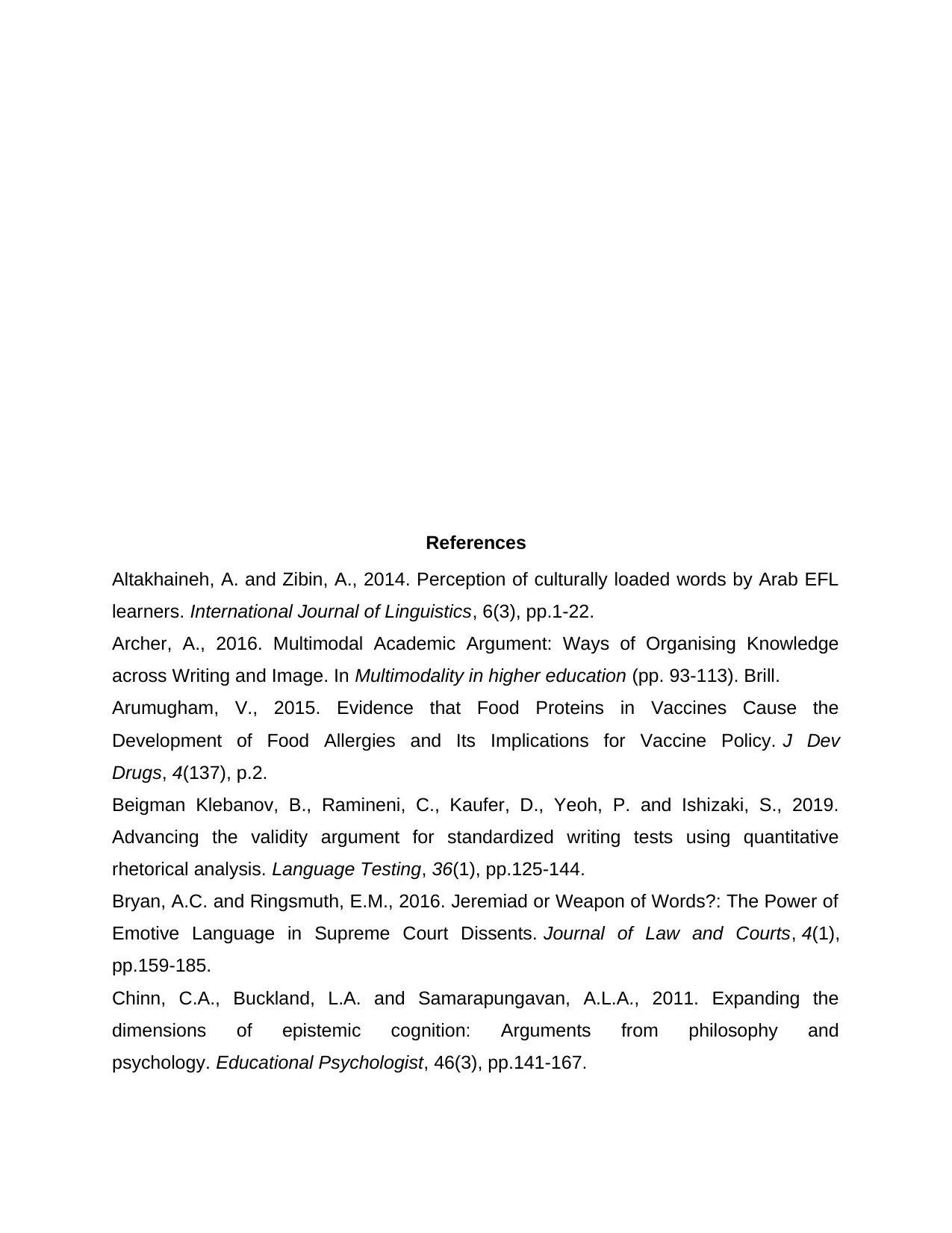
References
Altakhaineh, A. and Zibin, A., 2014. Perception of culturally loaded words by Arab EFL
learners. International Journal of Linguistics, 6(3), pp.1-22.
Archer, A., 2016. Multimodal Academic Argument: Ways of Organising Knowledge
across Writing and Image. In Multimodality in higher education (pp. 93-113). Brill.
Arumugham, V., 2015. Evidence that Food Proteins in Vaccines Cause the
Development of Food Allergies and Its Implications for Vaccine Policy. J Dev
Drugs, 4(137), p.2.
Beigman Klebanov, B., Ramineni, C., Kaufer, D., Yeoh, P. and Ishizaki, S., 2019.
Advancing the validity argument for standardized writing tests using quantitative
rhetorical analysis. Language Testing, 36(1), pp.125-144.
Bryan, A.C. and Ringsmuth, E.M., 2016. Jeremiad or Weapon of Words?: The Power of
Emotive Language in Supreme Court Dissents. Journal of Law and Courts, 4(1),
pp.159-185.
Chinn, C.A., Buckland, L.A. and Samarapungavan, A.L.A., 2011. Expanding the
dimensions of epistemic cognition: Arguments from philosophy and
psychology. Educational Psychologist, 46(3), pp.141-167.
Altakhaineh, A. and Zibin, A., 2014. Perception of culturally loaded words by Arab EFL
learners. International Journal of Linguistics, 6(3), pp.1-22.
Archer, A., 2016. Multimodal Academic Argument: Ways of Organising Knowledge
across Writing and Image. In Multimodality in higher education (pp. 93-113). Brill.
Arumugham, V., 2015. Evidence that Food Proteins in Vaccines Cause the
Development of Food Allergies and Its Implications for Vaccine Policy. J Dev
Drugs, 4(137), p.2.
Beigman Klebanov, B., Ramineni, C., Kaufer, D., Yeoh, P. and Ishizaki, S., 2019.
Advancing the validity argument for standardized writing tests using quantitative
rhetorical analysis. Language Testing, 36(1), pp.125-144.
Bryan, A.C. and Ringsmuth, E.M., 2016. Jeremiad or Weapon of Words?: The Power of
Emotive Language in Supreme Court Dissents. Journal of Law and Courts, 4(1),
pp.159-185.
Chinn, C.A., Buckland, L.A. and Samarapungavan, A.L.A., 2011. Expanding the
dimensions of epistemic cognition: Arguments from philosophy and
psychology. Educational Psychologist, 46(3), pp.141-167.
Paraphrase This Document
Need a fresh take? Get an instant paraphrase of this document with our AI Paraphraser
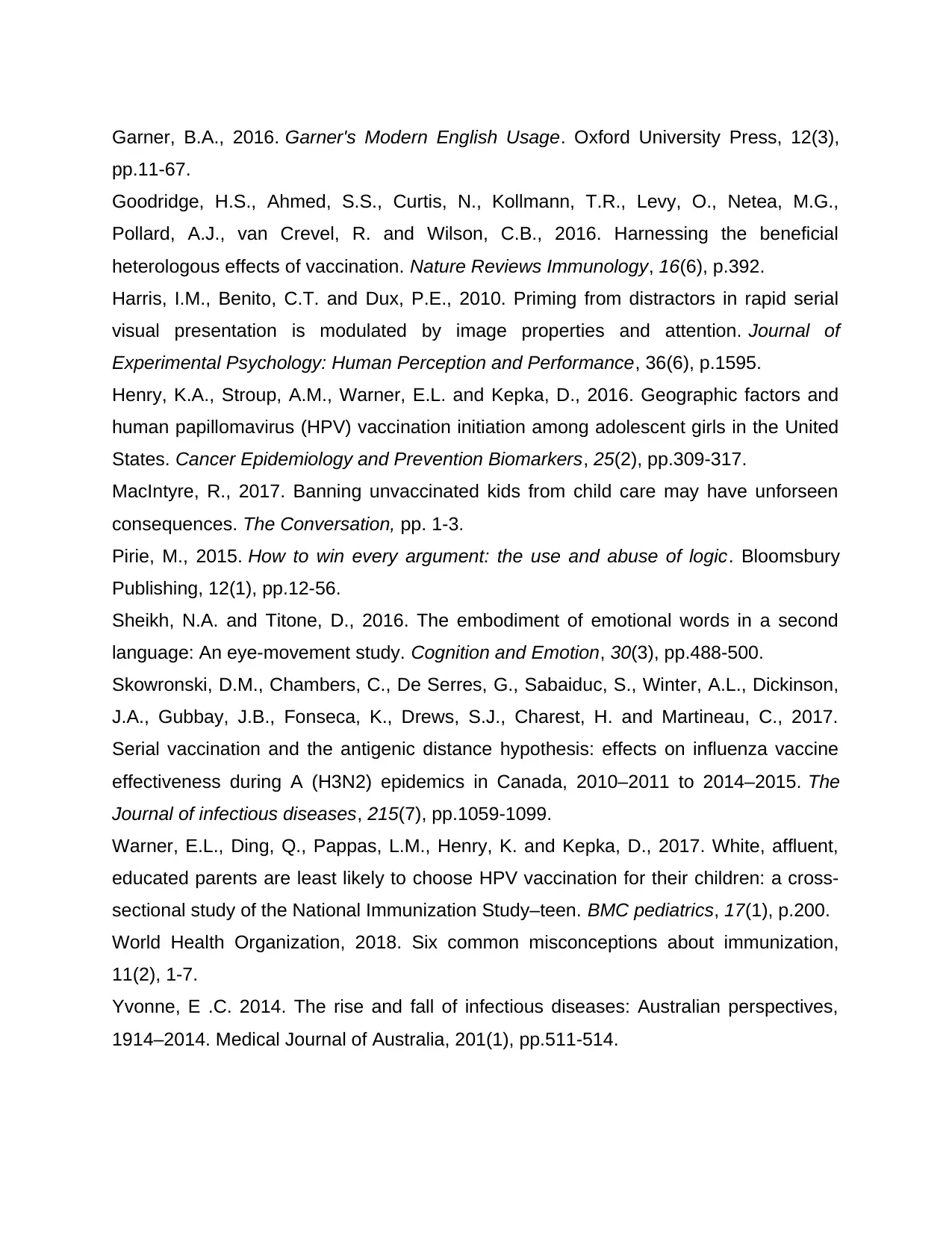
Garner, B.A., 2016. Garner's Modern English Usage. Oxford University Press, 12(3),
pp.11-67.
Goodridge, H.S., Ahmed, S.S., Curtis, N., Kollmann, T.R., Levy, O., Netea, M.G.,
Pollard, A.J., van Crevel, R. and Wilson, C.B., 2016. Harnessing the beneficial
heterologous effects of vaccination. Nature Reviews Immunology, 16(6), p.392.
Harris, I.M., Benito, C.T. and Dux, P.E., 2010. Priming from distractors in rapid serial
visual presentation is modulated by image properties and attention. Journal of
Experimental Psychology: Human Perception and Performance, 36(6), p.1595.
Henry, K.A., Stroup, A.M., Warner, E.L. and Kepka, D., 2016. Geographic factors and
human papillomavirus (HPV) vaccination initiation among adolescent girls in the United
States. Cancer Epidemiology and Prevention Biomarkers, 25(2), pp.309-317.
MacIntyre, R., 2017. Banning unvaccinated kids from child care may have unforseen
consequences. The Conversation, pp. 1-3.
Pirie, M., 2015. How to win every argument: the use and abuse of logic. Bloomsbury
Publishing, 12(1), pp.12-56.
Sheikh, N.A. and Titone, D., 2016. The embodiment of emotional words in a second
language: An eye-movement study. Cognition and Emotion, 30(3), pp.488-500.
Skowronski, D.M., Chambers, C., De Serres, G., Sabaiduc, S., Winter, A.L., Dickinson,
J.A., Gubbay, J.B., Fonseca, K., Drews, S.J., Charest, H. and Martineau, C., 2017.
Serial vaccination and the antigenic distance hypothesis: effects on influenza vaccine
effectiveness during A (H3N2) epidemics in Canada, 2010–2011 to 2014–2015. The
Journal of infectious diseases, 215(7), pp.1059-1099.
Warner, E.L., Ding, Q., Pappas, L.M., Henry, K. and Kepka, D., 2017. White, affluent,
educated parents are least likely to choose HPV vaccination for their children: a cross-
sectional study of the National Immunization Study–teen. BMC pediatrics, 17(1), p.200.
World Health Organization, 2018. Six common misconceptions about immunization,
11(2), 1-7.
Yvonne, E .C. 2014. The rise and fall of infectious diseases: Australian perspectives,
1914–2014. Medical Journal of Australia, 201(1), pp.511-514.
pp.11-67.
Goodridge, H.S., Ahmed, S.S., Curtis, N., Kollmann, T.R., Levy, O., Netea, M.G.,
Pollard, A.J., van Crevel, R. and Wilson, C.B., 2016. Harnessing the beneficial
heterologous effects of vaccination. Nature Reviews Immunology, 16(6), p.392.
Harris, I.M., Benito, C.T. and Dux, P.E., 2010. Priming from distractors in rapid serial
visual presentation is modulated by image properties and attention. Journal of
Experimental Psychology: Human Perception and Performance, 36(6), p.1595.
Henry, K.A., Stroup, A.M., Warner, E.L. and Kepka, D., 2016. Geographic factors and
human papillomavirus (HPV) vaccination initiation among adolescent girls in the United
States. Cancer Epidemiology and Prevention Biomarkers, 25(2), pp.309-317.
MacIntyre, R., 2017. Banning unvaccinated kids from child care may have unforseen
consequences. The Conversation, pp. 1-3.
Pirie, M., 2015. How to win every argument: the use and abuse of logic. Bloomsbury
Publishing, 12(1), pp.12-56.
Sheikh, N.A. and Titone, D., 2016. The embodiment of emotional words in a second
language: An eye-movement study. Cognition and Emotion, 30(3), pp.488-500.
Skowronski, D.M., Chambers, C., De Serres, G., Sabaiduc, S., Winter, A.L., Dickinson,
J.A., Gubbay, J.B., Fonseca, K., Drews, S.J., Charest, H. and Martineau, C., 2017.
Serial vaccination and the antigenic distance hypothesis: effects on influenza vaccine
effectiveness during A (H3N2) epidemics in Canada, 2010–2011 to 2014–2015. The
Journal of infectious diseases, 215(7), pp.1059-1099.
Warner, E.L., Ding, Q., Pappas, L.M., Henry, K. and Kepka, D., 2017. White, affluent,
educated parents are least likely to choose HPV vaccination for their children: a cross-
sectional study of the National Immunization Study–teen. BMC pediatrics, 17(1), p.200.
World Health Organization, 2018. Six common misconceptions about immunization,
11(2), 1-7.
Yvonne, E .C. 2014. The rise and fall of infectious diseases: Australian perspectives,
1914–2014. Medical Journal of Australia, 201(1), pp.511-514.
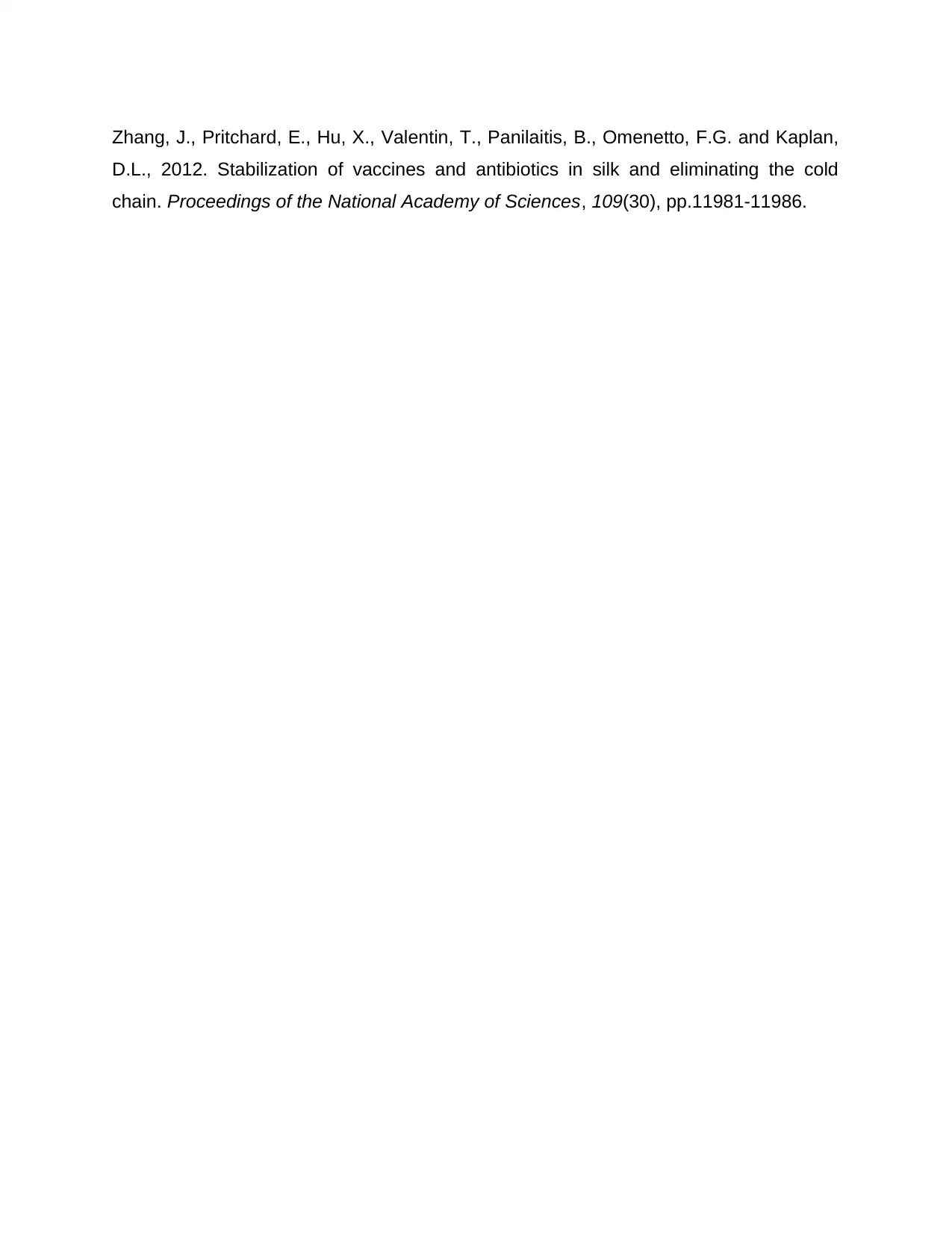
Zhang, J., Pritchard, E., Hu, X., Valentin, T., Panilaitis, B., Omenetto, F.G. and Kaplan,
D.L., 2012. Stabilization of vaccines and antibiotics in silk and eliminating the cold
chain. Proceedings of the National Academy of Sciences, 109(30), pp.11981-11986.
D.L., 2012. Stabilization of vaccines and antibiotics in silk and eliminating the cold
chain. Proceedings of the National Academy of Sciences, 109(30), pp.11981-11986.
⊘ This is a preview!⊘
Do you want full access?
Subscribe today to unlock all pages.

Trusted by 1+ million students worldwide
1 out of 12
Your All-in-One AI-Powered Toolkit for Academic Success.
+13062052269
info@desklib.com
Available 24*7 on WhatsApp / Email
![[object Object]](/_next/static/media/star-bottom.7253800d.svg)
Unlock your academic potential
Copyright © 2020–2025 A2Z Services. All Rights Reserved. Developed and managed by ZUCOL.
